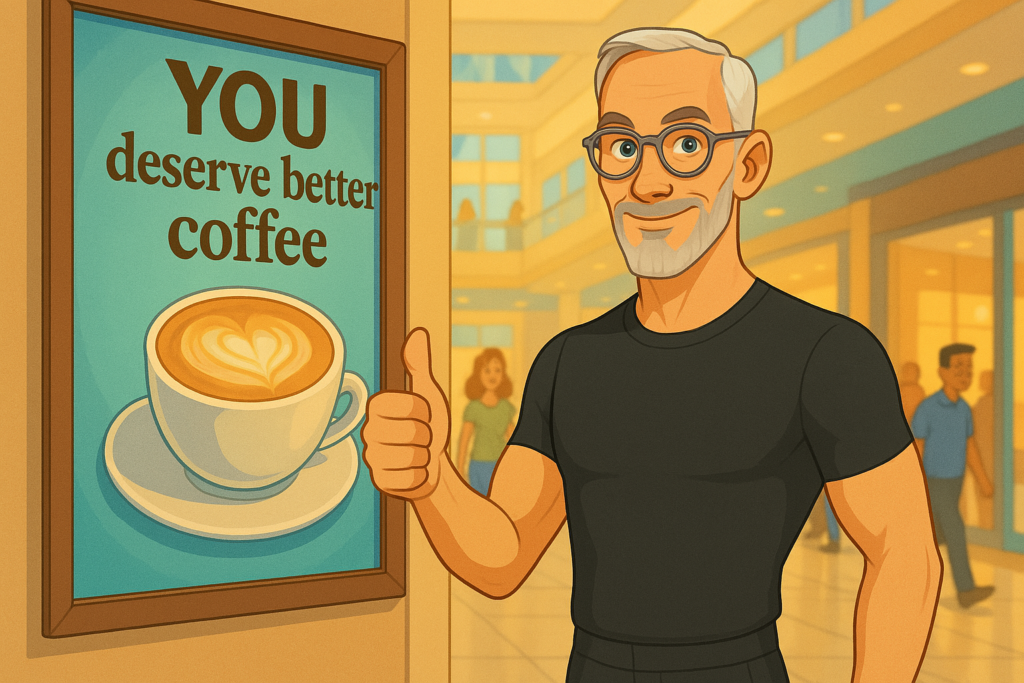
I was walking through a mall yesterday when a poster caught my eye.
“YOU deserve better coffee.”
Four simple words. No sexy visuals, no celebrity endorsement.
Just a direct appeal that made me nod in agreement. (And yes, I bought the coffee.)
That tiny word “you” carries surprising psychological appeal. It’s the difference between talking AT someone and talking TO them.
It’s perhaps the most reliable way to break through the 10,000+ marketing messages bombarding your customers daily.
“You” transforms your message from a broadcast into a conversation.
It pulls your prospect into the story, making them the main character rather than a passive observer.
In I Need That, I discuss how the dog brain — our emotional, impulsive and shamelessly self-centred limbic system — responds most strongly to personal relevance. “You” triggers this personal relevance like nothing else.
Consider these classic campaigns that harnessed its power:
Apple’s iPod: “1,000 songs in YOUR pocket” (not “our device holds 1,000 songs”)
Uber: “Your day belongs to YOU” (not “our service saves time”)
De Beers: “Show her YOU’d marry her all over again” (not “our diamonds symbolize commitment”)
U.S. Army: “Be all YOU can be” (not “we offer career opportunities”)

Each example puts the customer — not the product — at the center of the main narrative.
The Army ain’t selling military service (as glamorous as it looks); it’s offering to bring out YOUR personal highest potential. They revived this slogan, which I remember from the 80s, in 2023 because it resonated so deeply.
De Beers is bolstering YOUR expression of love, not flogging a sparkly billion-year-old commodity.
Uber offers YOUR freedom and control, not a ride in someone else’s car.
But here’s where marketers often mess up:
They use “you” without truly adopting the customer’s perspective.
“YOU will love our revolutionary new interface!” isn’t customer-centered — it’s still product-obsessed, just with “you” awkwardly bolted on.
Adding “you” is not enough.
Here’s the secret.
When you use “you,” follow it with something the ideal buyer really, truly cares about.
“YOU will save 3 hours every week” works.
“YOU will appreciate our patented algorithm” not so much.
Product Payoff: Spotify masterfully used this approach with its personalized year-end “Wrapped” campaigns. Rather than saying “We analyzed your data,” they frame it as “YOUR year in music.” This seemingly small shift helped transform a potential privacy concern into a hugely popular annual event that drives massive engagement. It’s entirely about the customer. Since introducing this you-centered approach in 2016, Spotify has seen Wrapped shares increase by over 300%, with a record 120 million users engaging with the first week of the 2023 campaign.
Action for today: How about YOUR current marketing materials? Count how many sentences start with “we” versus “you.” Then rewrite three key messages, shifting the focus from what you offer to what your customer experiences. Remember, this isn’t just changing pronouns. (I’m totally fine with that.) We’re changing perspective to genuinely address what matters most to your buyers.
Do you have examples of you-centered marketing that grabbed your attention?
Or cringe-worthy attempts that missed the mark? Tap that reply arrow and share your experience — I can’t wait to hear what has worked on … YOU.
And you know I’ll write you back.
Or reach out to the amazing team of customer-centered product marketing experts at Graphos Product.
